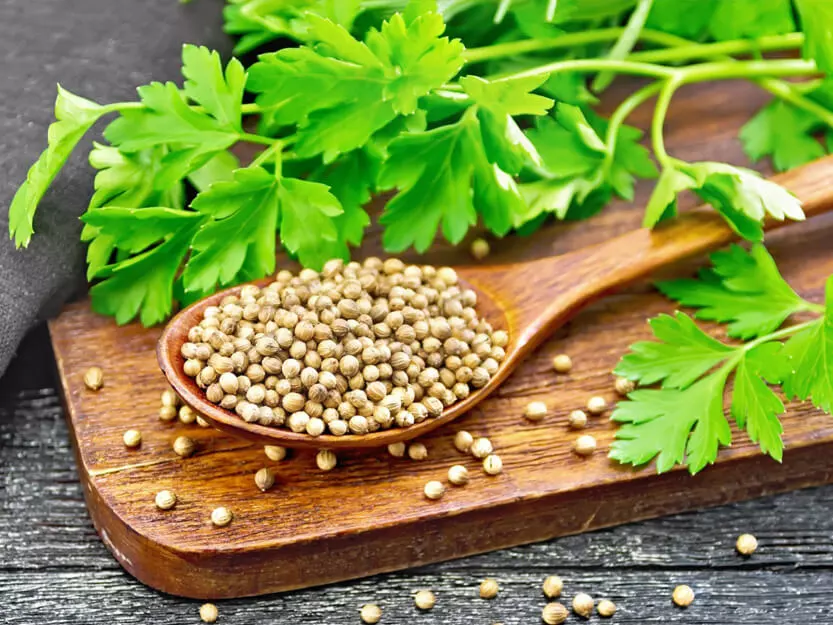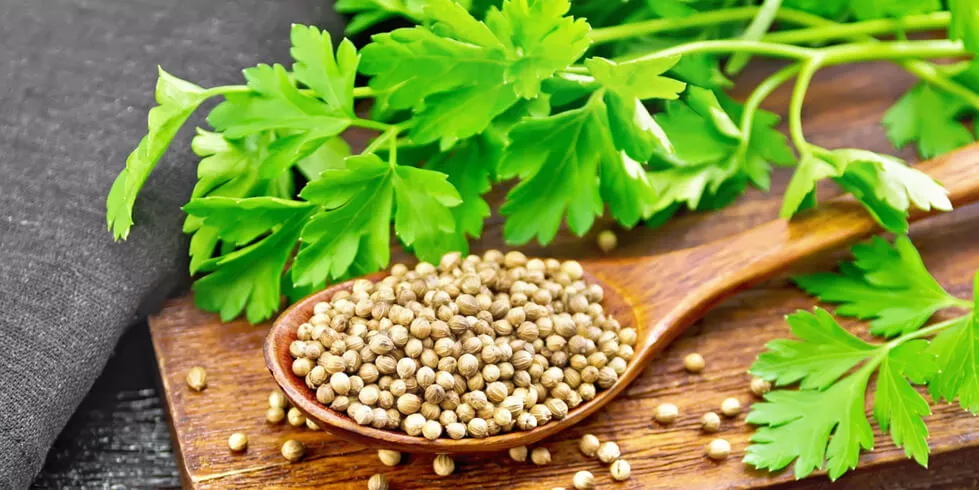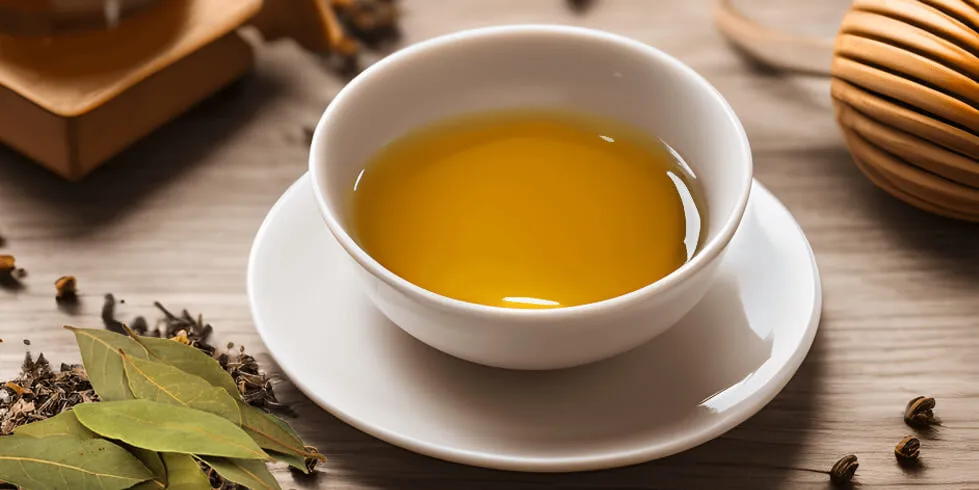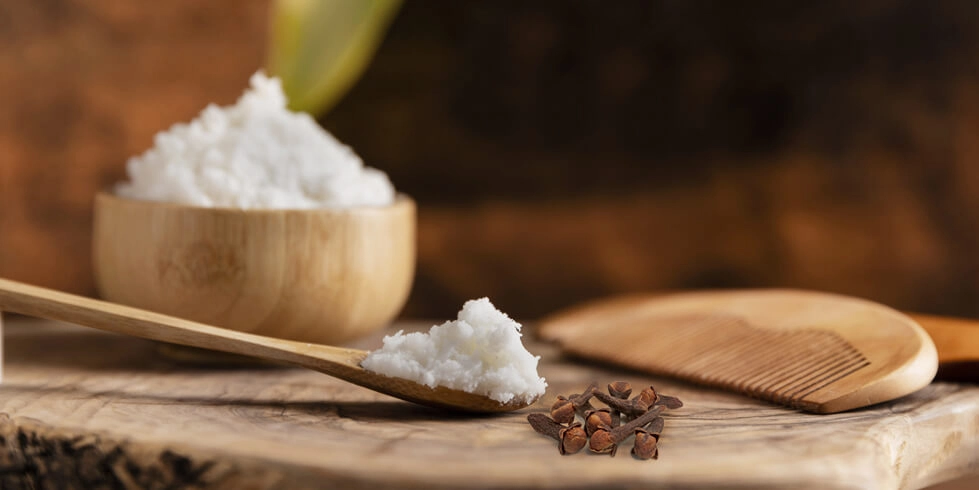Coriander is a bright-green, multi-branched biennial herb with crisp leaves and greenish-yellow flowers. It is often used as a seasoning or garnish and has a fresh, slightly peppery flavour.
Coriander is an aromatic herb used in culinary preparations as a flavouring and spice, having many health benefits.
Varieties of coriander
There are more than 30 kinds of coriander, but the curly-leaf and flat-leaf varieties are the most often used in the United States. Moss Curled, Green Velvet, and Paramount Imperial are among the curled parsley.
The flat-leaved variety, most commonly used in southeastern Europe and Asia, has a more vibrant flavour than the curled types.


Benefits of Coriander | Coriandrum Sativum
Coriander is a herb used in many dishes and has many health benefits. It helps digestion, heart health, and the immune system because it contains antioxidants and can stop inflammation.
Coriander has also been shown to reduce anxiety and lower blood sugar levels. But some people might have side effects like allergies, skin irritations, or stomach problems. Coriander should only be used in small amounts, and you should talk to a doctor if you have any bad reactions.
Benefits of Coriander | Chinese parsley
Coriander is a herb that is used to add flavour to dishes. The Coriandrum sativum plant has two parts. Its fresh leaves are known as cilantro, while the seeds are called coriander. In Asian, Middle Eastern, and Indian cuisines, coriander finds its place when it is added to soups and curries.
Fresh coriander leaves have various health benefits, along with dried coriander seeds. The coriander leaves are used in multiple dishes for garnishing and adding flavour.Let’s talk about the top health benefits of coriander.
1- Helps combat diabetes
Diabetes is a severe issue; many people look for natural ways to maintain their blood sugar level, and coriander leaves are known to maintain blood sugar.
Recent studies have shown that certain compounds found in coriander seeds are beneficial to keeping the blood glucose level under control. So, you need to add coriander seeds to your diet because they effectively lower blood sugar.
2- Improves digestion
The coriander seeds come with antioxidants and dietary fibre that are very helpful for people facing indigestion. When you use coriander leaves, the digestion process is improved, and you no longer experience stomach aches and bloating. All your meals must include cilantro and coriander seeds to have better digestion.
3- Improve your skin
If you have skin problems such as itching, rashes, eczema, or skin inflammation, experts advise using coriander seeds because of their antiseptic properties. Linoleic acid is found in coriander seeds and is very good at relieving pain and irritation. You can make a coriander face mask to radiate your face.
4- Boosts immune system
Coriander seeds are full of antioxidants that have anti-inflammatory effects. When you use coriander leaves, your immune system will be robust, and all your organs will work well. These seeds will also naturally detoxify your body. You can make infused tea using coriander seeds to improve your immune response.
5- Good for heart health
Coriander leaves have been shown to reduce the risk of heart disease. If you have a high blood pressure problem, use coriander seeds to lower it. LDL cholesterol harms health, and coriander seeds significantly reduce LDL cholesterol. So, you must add cilantro to your diet to keep your heart healthy.
6- Promotes hair growth
People with hair fall, dandruff, and frizz can use coriander seeds to make their hair healthy. You can make a hair mask using coriander seeds to strengthen hair follicles and promote growth. Once you use coriander seeds for hair fall, you will see significant results.
7- Relieves flu and cold symptoms
Coriander seeds are loaded with antioxidants that relieve cold and flu symptoms. Coriander seeds have vitamins C, A, folic acid, and beta-carotene, all of which can help eliminate a cold or flu. You can make ginger and coriander seed water to treat coughs and the common cold.
8- Ease menstrual cramps
The use of coriander seeds is widespread to relieve menstrual cramps. When you use these seeds, which make the endocrine glands work, the hormonal imbalance doesn’t change. Women with mental problems, heavy bleeding, and painful periods should use coriander water to ease abdominal cramps.
9- Help keep your eyes healthy
Our grandmothers told us to put coriander in our food to keep our eyes healthy. It is because coriander leaves contain incredible eye nutrients, like vitamins A, C, and E, and carotenoids.
The vitamins also help keep your eyes healthy, prevent age-related macular degeneration, and treat conjunctivitis. Studies have also shown that coriander contains age-related macular degeneration (ARMD) and heals conjunctivitis when it is eaten every day.
10- Promote healthy vision
The bright green colour of coriander comes from antioxidants, which can help enzymes work better. So, it makes the body make more insulin, which can lower the amount of sugar in the blood.
A person with high blood sugar can benefit from adding coriander to every meal or drinking coriander-infused water daily.
11- May help regulate blood sugar levels
With how people live now, every third person has problems with high cholesterol. Coriander leaves can help lower LDL (bad) cholesterol and raise HDL (good) cholesterol.
12- Healthy bones
Minerals like calcium, manganese, magnesium, and phosphorus are found in high amounts in coriander leaves. The anti-inflammatory effect of coriander also keeps the bones from hurting from arthritis.
13- May help lower bad cholesterol
The bright green colour of coriander comes from antioxidants, which can help enzymes work better. So, it makes the body make more insulin, which can lower the amount of sugar in the blood. A person with high blood sugar can benefit from adding coriander to every meal or drinking coriander-infused water daily.
14- May help promote gut health
Coriander leaves have a lot of fibre, which helps with digestive issues. It is also being looked at as a treatment for stomach upset, diarrhoea, cramps in the intestines, gas, or nausea.
15- Protect your brain
In several studies, coriander extract kept brain cells from getting hurt and helped mice remember things better. This may be because coriander can stop inflammation, the leading cause of most types of dementia.
Another surprising benefit was that coriander extract was just as good as existing anxiety medicines at treating anxiety symptoms in mice.
16- Getting rid of infections
Due to the plant compounds in coriander, it has antiseptic properties that can help with problems like infections caused by food. One of these chemicals is called “duodenal,” It might be perfect for treating salmonella infections.
It has also been shown that coriander seeds can help protect against urinary tract infections. Coriander oil can also be added to antimicrobial products to help fight foodborne diseases.
You can get the anti-infection benefits of coriander either by eating the herb itself or by using a wide range of products containing coriander extracts.
17- Reduce inflammation and swelling
They help arthritis and rheumatism sufferers by reducing inflammation and swelling around the joints.
18- Cleanness of the kidneys and liver
They make you go to the bathroom more often, which cleans your kidneys and liver and removes water retention.
19- Intestinal worms
Consuming coriander regularly also eliminates intestinal worms.
20- Antimicrobial properties
The leaves have antiseptic properties that prevent food poisoning in unrefrigerated foods.
21- Mouth ulcers
You can use them with your regular toothpaste to heal mouth ulcers and freshen your breath.
22- Easily added to the diet
Fresh coriander leaves are easy to find at most fresh produce markets, and many grocery stores also sell coriander seeds, dried coriander leaves, and coriander powder. Coriander can be added to salads or used as a garnish for many dishes.
The seeds can be used in roasts, baked goods, pickles, vegetable dishes, and other dishes. Lastly, you can make a great pickle with garlic, lemon juice, coconut milk, and peanuts. You can blend coriander leaves and add a little oil. Who can be used to flavour delicious meals such as pizza, curry, carrot soup, etc.?
How to choose and store coriander
Choose bunches of coriander that look just picked and not wilted or yellowed. Fresh coriander can be kept in the fridge for up to a week if wrapped in damp paper towels and an open plastic bag.
How to grow coriander at home
You can quickly grow coriander at home from seed. Scatter the seeds in a pot of soil, and cover lightly with compost. Water regularly for a large crop. Be sure to keep them in full sun and indoors in cold weather.
Coriander Side Effects
Coriander, also called cilantro, is often used in cooking and old-fashioned medicine. Coriander is generally considered safe, but some people may have problems after eating it.
Reactions to allergies
Coriander can cause hives, itching, swelling, and trouble breathing in some people who are allergic to it.
Gastrointestinal issues
Consuming coriander can sometimes cause gastrointestinal problems such as stomach pain, nausea, and diarrhoea.
Problems with the skin
Coriander can sometimes irritate the skin, especially in people allergic to it.
Increased sensitivity to sunlight
After eating coriander, some people may become more sensitive to sunlight, which can cause skin reactions like redness and blisters.
Interference with medications
Coriander can cause problems with some medicines, especially those that thin the blood, and may make it more likely that you will bleed.
Hypotension
In rare cases, eating a lot of coriander can cause your blood pressure to drop, making you feel dizzy or even pass out.
Drugs interaction
Coriander can cause a drop in blood sugar when taken with certain medicines, especially those used to treat diabetes.
Miscarriage
Evidence shows that eating a lot of coriander while pregnant may raise the risk of miscarriage.
It’s important to remember that the above side effects are uncommon and usually only happen to people who eat a lot of coriander or already have a health problem. If any of these things occur to you after eating coriander,
you must see a doctor immediately. Before taking coriander or any other spice for medicinal purposes, talking to a doctor or other health professional is always best.
Uses of coriander
The curly-leaved varieties of coriander are used as a flavouring, a salad ingredient, and a garnish. Flat-leaf coriander is often used as a seasoning in Italian cooking because of its more potent flavour.
Coriander is a bright-green, multi-branched biennial herb with crisp leaves and greenish-yellow flowers. It is often used as a seasoning or garnish and has a fresh, slightly peppery flavour.
Today, coriander is mainly used to flavour and decorate food coriander is a tough plant that grows almost anywhere. Putting the seeds in water for a night before planting them helps them grow. The types of parsley with flat leaves grow faster than the ones with curly leaves.
Nutritional aspects of Coriander
This plant is known as a storehouse of bioactive due to its rich nutritional and bioactive compounds. Green leaves and dry coriander are responsible for their nutrition. The nutritional value of fresh leaves is entirely different from that of dried seeds.
The leaves are especially rich in vitamins A and C, while their dry seeds contain significant amounts of other minerals and dietary fibre. It turns out that green coriander leaves are low in saturated fat and cholesterol and contain appreciable amounts of thiamine, zinc, and crude fibre.
The leaves are a good source of carotene and act as a precursor to vitamin A. Dried coriander seeds are essential to Indian cuisine and the history of Indian Ayurvedic medicine. Seeds contain zero percent cholesterol (USDA).
Coriander seeds are one of the best food sources of potassium. Other minerals, like calcium, phosphorus, magnesium, sodium, and zinc, are crucial for the body’s cells to work correctly. Total vitamin C is also present in sufficient quantity.
Origin & botanical facts of coriander
coriander is believed to have originated in southern Europe, around the Mediterranean, and has been cultivated since about 320 B.C. In ancient times, coriander reaths were thought to ward off drunkenness.
According to Greek mythology, parsley sprang from the blood of Opheltes, the infant son of King Lycurgus of Nemea, who was killed by a serpent while his nurse directed some thirsty soldiers to water.
Thus, Greek soldiers associated parsley with death and avoided contact before the battle. A completely different meaning is imparted to the herb in the Jewish seder, the Passover meal. Because coriander is one of the first herbs to appear in the spring, it is used in the seder to symbolize new beginnings.
The ancient Romans ate coriander after meals to freshen their breath, and the Roman physician Galen prescribed it for epilepsy and as a diuretic. In Europe during the Middle Ages, parsley was regarded as the devil’s herb and was believed to bring disaster to anyone who grew it unless it was planted on Good Friday.
Nevertheless, medieval abbess and herbalist Hildegard of Bingen and the 17th-century herbalist Nicholas Culpeper prescribed it in various forms for heart and chest pain and arthritis.
During the late 19th and early 20th centuries, parsley was named for multiple medical conditions. However, these uses have yet to be recognized in modern medicine.
Today, coriander is used primarily as a flavouring agent and a garnish. coriander is a hardy plant that can be grown quickly in almost any soil. It can be planted in the spring for summer use and in late summer for winter growth and spring harvesting.
Soaking the seeds overnight before planting helps germination. Flat-leaved coriander is cultivated more quickly than the curly-leaved types.
The Author’s Message
I hope you enjoyed my blog about the Benefits of Coriander | Chinese parsley. I’m not saying that coriander is the perfect food for everyone, but there are many health benefits.
I encourage you to try coriander to see if it helps your health. If you’re uncertain about what to do, I would love to hear from you through this blog post.
Thank you for reading. I’m always excited when my blog posts can provide helpful information on a topic like this!
FAQs
Coriander and cilantro are two terms that refer to different parts of the same plant, Coriandrum sativum.
The leaves and stem of the plant are commonly referred to as cilantro, while the seeds of the plant are referred to as coriander.
Here are some key differences between the two:
Appearance: Cilantro has green, flat, and feathery leaves, while coriander seeds are small, round, and brown.
Taste: Cilantro has a pungent, citrusy, and slightly bitter taste, while coriander seeds have a warm, sweet, and slightly spicy flavor.
Culinary use: Cilantro is commonly used as a herb in many cuisines around the world, while coriander seeds are used as a spice in cooking.
Geographic variation: The term “cilantro” is commonly used in the Americas, while in other parts of the world, including Europe, the plant is typically referred to as coriander.
It’s worth noting that some people have a genetic predisposition to find cilantro’s flavor unpleasant or soapy-tasting, while others enjoy it. This may contribute to different preferences for the use of the plant in cooking.
Coriander (Coriandrum sativum) is both a spice and an herb.
The leaves of the coriander plant are commonly referred to as cilantro and are used as an herb in many cuisines around the world.
The seeds of the same plant are used as a spice in cooking, and they have a slightly sweet, citrusy flavor that pairs well with many dishes. In some countries, the root of the coriander plant is also used as a spice.
While coriander and cilantro come from the same plant, they have distinct flavors and are typically used in different ways in cooking. As a result, it may not be appropriate to use them interchangeably in all recipes.
For example, cilantro is commonly used as a fresh herb in dishes like salsa, guacamole, and ceviche, where its bright, citrusy flavor is a key ingredient. Coriander, on the other hand, is often used as a spice in curries, stews, and spice blends, where its warm, slightly spicy flavor adds depth and complexity to the dish.
That being said, there are some recipes where you could potentially use coriander and cilantro interchangeably, especially if you’re looking to experiment with different flavors. For example, you might try using fresh cilantro leaves in a spice blend that calls for ground coriander, or adding ground coriander seeds to a dish that typically calls for fresh cilantro.
Ultimately, the decision to use coriander or cilantro in a recipe will depend on the specific flavor profile you’re looking to achieve, as well as the cooking techniques you’re using.



